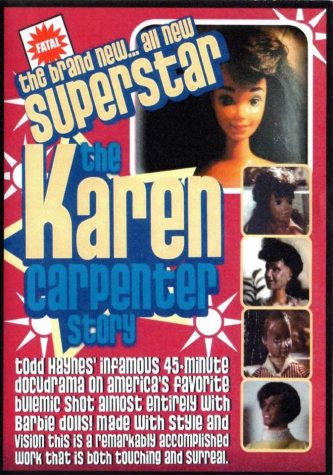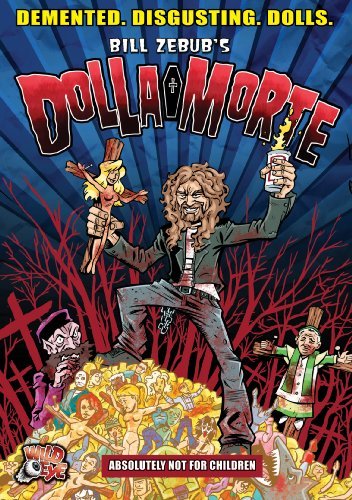According to a July, 2023 FILM COMMENT anecdote, the veteran film critic Amy Taubin was asked her opinion of BARBIE by an elevator companion, to which she allegedly retorted “It’s about a fucking doll.” To that I have two responses: 1). BARBIE features a flesh-and-blood actress playing the doll in question, and so isn’t really about a “fucking doll,” and 2). What exactly is wrong with movies about dolls? Judging by BARBIE’s monster success, the public is evidently far less concerned about that fact than Taubin.
BARBIE’s popularity has had an unexpected but welcome side-effect: Todd Haynes’s obscure 1985 short SUPERSTAR: THE KAREN CARPENTER STORY has been thrust back into the spotlight. Why? Because Haynes’ film, made as a student project for Bard College, was peopled entirely with Barbie dolls. As we’ll see, it was neither the first nor the last Barbie headlined film, but SUPERSTAR was and remains the most accomplished such effort by far, proving that (contrary to what Ms. Tobin intimated) films about dolls can be artful and touching. Whether the other Barbie films I mentioned can replicate those attributes is something I’ll examine in a bit, but right now let’s concentrate on SUPERSTAR.
This 43-minute film explores the life of the late singing sensation Karen Carpenter (1950-83) through Barbie and Ken dolls (purchased by Haynes at garage sales). The gambit might seem in questionable taste, and probably is, but it makes sense given that these ultra-thin dolls have long been notorious for negatively impacting the body image of young girls the world over, and that Karen Carpenter died of complications from anorexia brought on by severe body dysmorphia.
As scripted by Haynes and Cynthia Schneider, SUPERSTAR falls somewhere between a serious inquiry into the horrors of anorexia (complete with “educational” interludes filling us in on the particulars of the disorder) and a perverse (if unusually thoughtful) exploitation drama. We see Karen C. go from a bright-eyed young Barbie concerned about her weight to an unstable pop star with a spanking fixation as the film devolves into an increasingly dark and unsettling psychofest.
The soundtrack is papered with Carpenter tunes that were used without permission (because, according to longtime Haynes collaborator Christine Vachon, “he didn’t expect it would blow up the way it did”), resulting in SUPERSTAR being pulled from circulation due to a 1990 lawsuit by Richard Carpenter (Karen’s bro). The ban remains in place today, although the film has long since become a greymarket sensation whose momentum shows no signs of waning.
But about those other Barbie peopled projects that preceded and followed SUPERSTAR…the whole mess began in 1977 with BARBIE, a ten minute short by the statuesque Tina L’Hotsky (1951-2008), a popular NYC night club-centered character. She appears stark naked in BARBIE, entering an apartment where she fries a Barbie doll in a pan, carefully seasons it and—still not bothering to clothe herself—sits down at a table and eats the thing. Yes, that’s about it for this short, which looks like it cost all of three dollars to make.
I’m guessing L’Hotsky didn’t bother obtaining official permission for the use of Barbie, an issue that apparently did affect Haynes—who, adding to his legal woes, was reportedly “paid a visit” by Mattel. COOL KIDS HIGH, an eight part shot-on-video series from 1991-92, also uses Barbie dolls as cast members, and once again appears to have done so without formal consent (although Barbie does get a thank you in the end credits).
Each episode of this program runs around eleven minutes (and concludes with a “To Be Continued…” scroll), and doesn’t appear to have cost much more to make than the abovementioned L’Hotsky short. The show’s auteur was the South Carolina based horrormeister Tommy Faircloth (CRINOLINE HEAD) at the very beginning of his career.
The eponymous high school is peopled by Barbie and Ken dolls held by oft-visible hands, with voice-over dialogue (the speakers are denoted by shaking the doll that’s supposed to be talking) and limbs made to move by jump cuts. These Barbies subside in an elaborately rendered miniature universe of pen and ink backdrops and various Barbie accessories (such as a corvette and a plant). Unfortunately Faircloth fails to do his ambitions justice, providing nonsensical soap opera narratives about a rigged student election and a Vanilla Ice concert, neither of which go anywhere very interesting.
Hailing from 2006, DOLLA MORTE was one of several SOV no-budgeters turned out by the New Jersey based death metal enthusiast Bill Zebub. Barbies feature heavily in DOLLA MORTE’s universe, which will never be confused for MEET THE FEEBLES or TEAM AMERICA—or, for that matter, SUPERSTAR.
DOLLA MORTE is in fact quite close, in look and attitude, to the puppet porn abomination LET MY PUPPETS COME (1976), with a sense of humor that exists on a third grade level and political satire to match. A George W. Bush doll turns up, as do representations of Saddam Hussain, the pope, Jesus Christ and lots of assorted Barbies—and what look like cheap knock-offs—seen getting raped, burned, impaled and crucified as death metal tunes play on the soundtrack.
The film ends with a disclaimer reading: “The characters in this movie are dolls. Don’t get mad.” Mattel, I’m guessing, would probably get quite mad at the outrages to which Zebub subjects his non-human cast, but DOLLA MORTE appears to have flown under the big boys’ radar (thus far).
Final thought: I long believed that SUPERSTAR was sui generis among Barbie doll peopled films and, based on the L’Hotsky BARBIE, COOL KIDS HIGH and DOLLA MORTE, it seems I was right.


